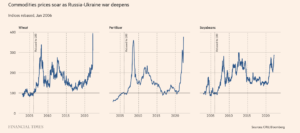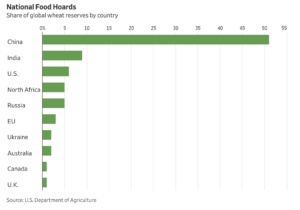China has bought at least 8 million tons of US soybeans this year, according to people familiar with the matter, putting the world’s top importer on track to meet a…
“It’s Going to be Real,” President Biden on War-Related Food Shortages
Bloomberg’s Josh Wingrove reported yesterday that, “President Joe Biden said that the world will experience food shortages as a result of Russia’s invasion of Ukraine, and production increases were a subject of discussions at a Group of Seven meeting on Thursday.
“‘It’s going to be real,‘ Biden said at a news conference in Brussels. ‘The price of the sanctions is not just imposed upon Russia. It’s imposed upon an awful lot of countries as well, including European countries and our country as well.'”
"It's going to be real," Biden says of war-related food shortages, "because both Russia and Ukraine have been the bread basket of Europe" for wheat. He says G7 talked about how to disseminate wheat more rapidly, and how to "end trade restrictions" on sending food abroad.
— Jennifer Jacobs (@JenniferJJacobs) March 24, 2022
“Biden said that at the G-7 summit in Brussels earlier that he and Canadian Prime Minister Justin Trudeau both discussed increasing their nation’s agricultural production to try to make up for shortfalls. Biden said he’s also urging all nations including those in Europe to drop trade restrictions that could restrict exports of food,” the Bloomberg article said.
Also yesterday, Bloomberg writers Mike Dorning, Jennifer Jacobs, and Josh Wingrove reported that, “President Joe Biden and the leaders of top U.S. allies are exploring how to keep Russia’s invasion of Ukraine from causing a spike in global hunger as the war increasingly disrupts supplies of wheat and other goods from a region known as one of the world’s breadbaskets.”
White House officials have held multiple discussions over the past week with national security, agriculture, development and Treasury officials to seek ways to prevent supply shortages and price hikes, according to people familiar with the conversations.
The Bloomberg article indicated that, “The food shock in Ukraine looks devastating. Grain and sunflower oil in storage from last year’s harvest can’t be shipped because of fighting and port closures. Shelling and fuel shortages may interfere with spring planting and fertilizer farmers need to apply to the winter wheat crop as it emerges from dormancy. Infrastructure damage, labor shortages and continuing conflict could also compromise the summer harvest and transportation of whatever is produced.”
During the meeting we agreed that in order to further strengthen #FoodSecurity, we also need to strengthen our farmers' economic viability and strengthen our economic models for the future CAP. https://t.co/Ynnn0LJh0u
— Janusz Wojciechowski (@jwojc) March 24, 2022
Reuters News reported today that, “[Ukraine’s new agriculture minister] Mykola Solskyi, who was appointed on Thursday, said global food prices would continue to rise if the situation in Ukraine following Russia’s invasion did not change.”
In an opinion column posted today at The Financial Times Online, Stefan Wagstyl pointed out that, “Rising food prices are ringing alarm bells for households all over the world. UK food banks say they have never been busier. Supermarkets in Italy have reported panic buying. And in Iraq there have been bread price protests.
“Food costs were increasing even before the Ukraine war, driven by higher energy prices, transport bottlenecks and, in some countries, farm labour shortages. Now Russia’s invasion has triggered further rises and concerns about prolonged disruption in agriculture-rich Ukraine.”

Meanwhile, Wall Street Journal writers Jon Emont and Silvina Frydlewsky reported in today’s paper that, “Fertilizer prices were already high before the war. They have now reached record levels amid a precipitous drop in Russian supply, according to CRU Group, which analyzes commodity markets. At the same time, more-expensive natural gas, another Russian export and a crucial ingredient in fertilizer-making, has led European fertilizer factories to scale back production.
The result is that fertilizer is about three to four times costlier now than in 2020, with far-reaching consequences for farmer incomes, agricultural yields and food prices.
“Fertilizer producers are warning of continuing shortages. After Russia’s invasion sent European natural-gas prices to record levels, many companies reduced production of ammonia, which is used to make nitrogen fertilizers. Although prices of European natural-gas futures have fallen since early March, they remain roughly 40% higher than they were before the invasion of Ukraine,” the Journal article said.
"We're going to see higher prices for fertilizer as we approach the spring planting season," Alexis Maxwell says. "We think it's going to take up about 50% of a farmers budget this year, normally they'd spend about 30% of their cash on producing crops." https://t.co/XMXBnrs3LU pic.twitter.com/7WNxWNuMKL
— Bloomberg TV (@BloombergTV) March 24, 2022
Also in today’s Wall Street Journal, Carol Ryan reported that, “Food stockpiles might look comfortable at the global level. In reality, only a handful of governments have provisions to cope with grain shortages caused by the war in Ukraine.
“For important cereals such as wheat and corn, the world-wide stock-to-use ratio—a measure of inventories as a proportion of annual demand—will finish the year at 29%, according to forecasts by the Food and Agriculture Organization of the United Nations. This is lower than before the pandemic, although not worryingly so.

“But the headline number is deceptive as a small number of countries control the biggest share. The U.S. Department of Agriculture estimates that China holds half of the world’s wheat reserves and 70% of its corn. After five consecutive record crops, India has almost one-tenth of global wheat stockpiles. The U.S. has 6% and 12% of global wheat and corn reserves, respectively. Combined, countries in North Africa that are especially reliant on grain imports from the Black Sea region have a roughly 5% share of global wheat reserves.”
Approximately 70% of winter #wheat production is within an area experiencing #drought. pic.twitter.com/wcLyczWWlc
— Farm Policy (@FarmPolicy) March 24, 2022
In production related news, Reuters writer Dominique Patton reported yesterday that, “China’s northern wheat growing region still has room for improvement, Chinese Premier Li Keqiang told a meeting on Thursday, and it is critical to support weak seedlings to ensure a bumper harvest.
“The country is facing new challenges in ensuring farm output, with rising global prices and volatility, but domestic supplies are sufficient, he also said, according to a state media report.”





